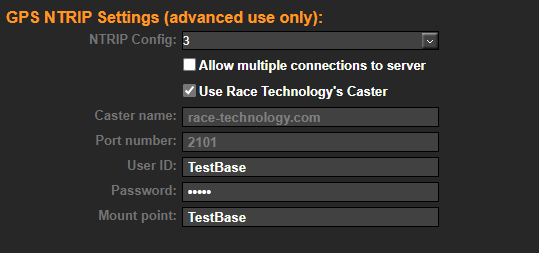Corrections via Internet and NTRIP / RT Base station
Quick Checklist
- If not previously done, register the GNSS2 on an RT Cloud account
- Configure the SIM card setup for the GNSS2 to allow internet data
- Sign up to an NTRIP service that can supply RTCM v3.x corrections valid for your location or have a Race Technology Base station set up to provide corrections
- Ensure a 4G LTE antenna is connected to the GNSS2.
- Ensure the GNSS2 is using the supplied dual frequency GPS+GLONASS antenna.
- Ensure a data-capable SIM card is inserted in the SIM card slot on the rear of the GNSS2.
Full Instructions
Before the RT GNSS2 can be used it must be registered to an RT Cloud account. For details on how to do that see here
The GNSS2 must also be configured to get corrections from either an NTRIP service or a base station, this is set on the RT Cloud server in the accounts page:
No specific configuration is required to get corrections over the internet for the GNSS2, if they are available they will be used.
'''NOTE 1: It is important that a 4G LTE antenna is connected to the GNSS2 whenever the unit is powered on. If this is not done, then the 4G LTE module may increase the power draw in an attempt to compensate, resulting in excess current consumption from the power supply, and reduced GNSS performance due to increased interference.
Note 2: When receiving internet corrections over 4G LTE, the GNSS2 will automatically retransmit them from RS232 port 2 at 38400 baud. This allows them to be forwarded on to one or more additional GNSS2 receivers using either serial cable or radio modems, and thus potentially allows multiple units to receive corrections from a single NTRIP source.'''
It is necessary to insert a data-capable SIM card (standard size) into the labelled SIM slot on the rear of the GNSS2. In most cases, no explicit configuration of the SIM card settings is required; the data SIM will simply connect automatically through it’s built in settings. If it is necessary to configure the GNSS2 to match your SIM provider's settings, then please refer to this link.
It is also necessary to subscribe to a provider of internet based corrections, which are provided through a protocol known as an NTRIP caster. There are free NTRIP casters available, but in our experience satisfactory operation has only been attained through subscribing to a paid professional service. It is necessary to carefully configure the GPS2 RTK to match the NTRIP caster settings supplied by your provider: full details on how to configure this can be found here.
Alternatively, a Race Technology Base station can be used to provide corrections. Configuration details for this can be found on this link.
Following these steps, the GNSS2 should achieve integer RTK differential lock (full accuracy) as long as adequate 4G LTE reception is available, and the GNSS2 has a clear view of the sky and is using the supplied dual frequency GPS+GLONASS antenna. To verify correct operation, check the data on LCD screen 1 to ensure that the 4G LTE is getting to step 15-15, and the correction age should be no more than a few seconds. The GNSS mode can be viewed on screen 4.
Typically, once differential lock has been attained, the GNSS2 will retain differential operation as long as GSM dropouts do not exceed more than approximately 30s in duration.

